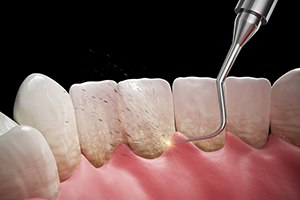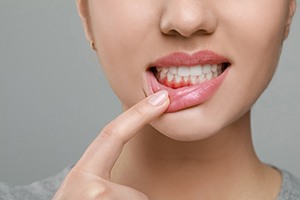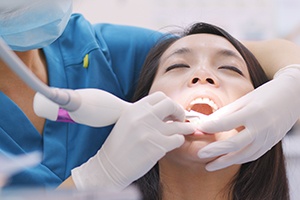Gum Disease Treatment – Michigan City, IN
Restore Sore, Aching Gum Tissue

Gum disease is very common. Nearly half of adults over the age of 30 have some form of gum disease, and this percentage increases with age! Over time, gum disease can lead to permanent damage and even tooth loss. The good news is that we offer gum disease treatment to restore sore, aching gum tissue. By getting treatment early on, you can prevent serious issues from developing. To learn more about gum disease or to schedule an appointment with us, give us a call!
What is Gum Disease?

Gum disease is an infection of the gums and supportive tissues. Most of the time, it is caused by plaque and tartar buildup as a result of poor oral hygiene. It can lead to permanent gum damage, tooth loss, and other serious health risks. There are two different stages of gum disease:
- Gingivitis: This is the earliest stage of gum disease and can be reversed by improving your dental hygiene routine and seeing your dentist.
- Periodontitis: This is the more advanced stage of gum disease. It can only be managed, not cured, in order to prevent worsening effects, like tooth loss.
Factors that can increase your risk of developing gum disease include, smoking and chewing tobacco, poor oral hygiene, genetics, immune-compromising conditions, certain medications, and hormonal changes resulting from pregnancy.
Symptoms of Gum Disease

It’s important to recognize symptoms so you know when changes need to be made. Here are some signs to look out for.
Gingivitis:
- Halitosis (bad breath)
- Red/swollen gums
- Bleeding when brushing and/or flossing
- Tender gums
- Gum recession
Periodontitis:
- Pain while chewing
- Loose teeth
- Sensitive teeth
- Bite chances
- Changes in the fit of restorations (partial denture, etc.)
- Permanent tooth loss
If you notice any of the symptoms listed above, let us know. This way, we can take a look at your smile and put together a treatment plan to improve the health of your smile.
How Do We Treat Gum Disease?

Scaling & Root Planing

If you have a typical case of gum disease, we’ll likely suggest scaling and root planing. This two-part procedure is a “deep cleaning” that removes bacteria from your teeth and gums. Scaling uses an ultrasonic cleaner to eliminate plaque beneath the gumline, while root planing smooths out your tooth roots. (The second step ensures your gums reattach healthily.) To learn more about the whole treatment, keep reading or call our office for details.
Do I Need Scaling & Root Planing?

Only dentists like ours can confirm if you need scaling and root planing. By checking your mouth, they’ll see if you show signs that could be eased by treatment. These include:
- A visible buildup of plaque
- Sensitive or bleeding gums
- Gum swelling or puffiness
- Receding gum tissue
- Persistent bad breath (i.e., halitosis)
The above signs can often be reversed with oral care, but you’ll need scaling and root planing if your infection is severe. Only treatment would manage your symptoms at that point.
The Process of Scaling & Root Planing

A scaling and root planing treatment is done over two dental visits. The initial scaling takes place at your first appointment, while the root planing occurs at the second one.
Our team will work carefully during the scaling phase of your treatment. To be precise, they’ll use a precise ultrasonic cleaner to remove plaque and tartar from your enamel. They’ll also move as far down as your gum pockets to ensure the best results.
For the root planing visit, we’ll finish up our care. It gets rid of bacterial deposits stuck to your tooth roots and smooths those roots afterward. Once those steps are done, your gum tissue will have a much lower risk of re-infection.
Aftercare Tips for Scaling & Root Planing

Since scaling and root planing can get invasive, your smile will need weeks to recover. You’ll also likely feel aches and pains during this healing period. Fortunately, you can manage any soreness with tips like the following:
- Eat Carefully – Stick to soft foods for the first two days after treatment, as this diet will prevent irritated gums. You should also avoid alcohol, acidic drinks, and anything spicy for a few weeks.
- Get Some R&R – Avoid intense physical movement right after treatment. If you don’t, you could overwork your body and delay your healing progress.
- Do Salt Water Rinses – For a few days after treatment, do salt water rinses after your meals. Swishing with salt water can reduce your gums’ irritation and loosen debris around your teeth.
- Brush Gently – Try gently brushing your teeth with a soft-bristled toothbrush. If you brush in slow and circular motions, you’ll prevent aches and pains in your gums.
